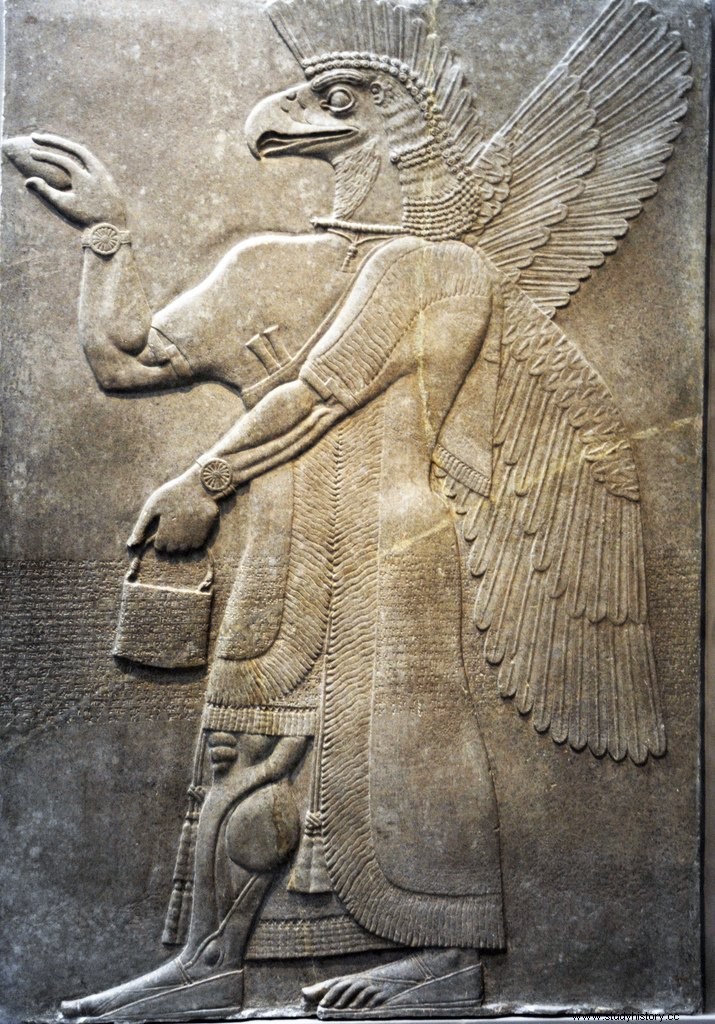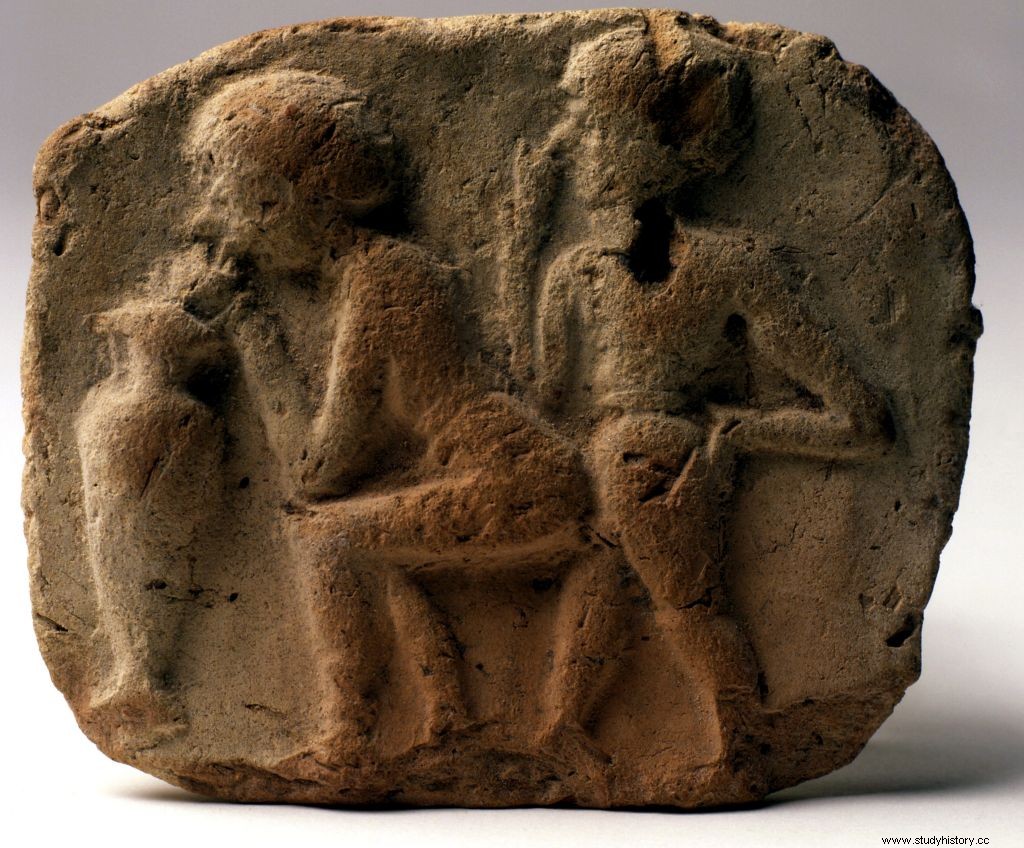In some Mesopotamian reliefs appears the figure of a being with the head of a bird, a muscular human body and beautiful wings, holding an object with a handle in one hand and a kind of pineapple in the other. It is the god Nisroch . It has become very popular thanks to the internet, since the magufa pages maintain that it is an alien, which would carry a bag in one hand (they do not explain in which supermarket it made the purchase) and a high-tech device in the other, on horseback between a digital-atomic-escarolitropic-gnesic-laser and Captain Kirk's communicator. The reality is a bit more vulgar. The shopping bag is a bucket of holy water, something very common in many religions, and the pineapple… is a pineapple. Or to be exact, it's a Mullilum (Akkadian) or Mash-Mash (Sumerian), that is, a hyssop, since in the Mesopotamian religion it was already customary to sprinkle holy water on the faithful, or in this case, on the gardens so that they would bear good fruit. Already since Sumerian times, the priests discovered that a pineapple was fantastic as a sprinkler. Over time they ended up manufacturing them with precious materials, as is typical of any religion.

Nisroch
But let's continue with good old Nisroch, who did not start his career by soaking the staff, but by making life miserable for him. The first references to him are found in Assyrian tablets, and he is described as a dangerous demon. We have already warned in other articles that the Mesopotamian demons were not evil in the Judeo-Christian sense that we are used to today. Even though they were depicted in terrifying forms, they were not malefic by nature. They were just doing their job, which was to piss off those who annoyed some god. I mean, it was nothing personal, just business. That means humans could turn to them for something good, if they gilded the pill long enough.
In his origin as a demon Nisroch was a servant of Nusku , the Assyrian god of fire and light. When someone bothered Nusku, or his hierarchical superior Ninurta , our demon was in charge of inspiring initiatives of a sexual nature that, on occasions, could have terrible consequences for the aforementioned. For example, incest, which in Mesopotamia could be punished with death, or infidelity, which as usual, in the case of men ended in a fine and in the case of women normally death. That was the unpleasant part. The good news is that it improved the atmosphere of the orgies. Nisroch was married to a demoness named Kenel , which she was fond of sleeping with humans and displaying an impressive sexual originality, apart from practicing voyeurism with her husband. Both constituted the most imaginative sexual duo of the two rivers. Come on, they didn't write the kamasutra because in cuneiform it wouldn't have been very suggestive. On some websites they indicate that this is part of its evil aspect -we return with it to the interpretations influenced by the Judeo-Christian culture-. For the Mesopotamians, sex was neither negative nor bad. The Assyrians, in particular, were fond of having the occasional orgy from time to time. Therefore, invoking a demon that was going to inspire you with a new posture with which to end the night with a smile on your lips, there was nothing wrong with it. On the contrary, it was highly recommended.

And it is between debauchery and bacchanals that Nisroch began to rise through the ranks like foam. With him there was one of those caroms that sometimes happened in Mesopotamian mythology, because with a pantheon made up of thousands of gods it was normal for one to lose influence and another to gain it. Important gods in early times ended up half-forgotten, and mindundis that no one spoke of at Enki's palace receptions ended up with ziggurats of their own. Nusku lost importance little by little, they even changed its name to Girru in Babylonian times, perhaps to make clear his loss of influence. Nisroch, on the other hand, due to the fact that he was used from time to time, at parties and on Saturday nights, was on everyone's lips, and we already know that it is better that they speak of one even if it is bad, but that they speak . As expected, he ended up taking on himself the divine characteristics of Nusku and being deified. A curious proof of this, apart from the references in more recent tablets where he is already named as a god, is that in the Bible the Jews confused him with one of the great chiefs of the pantheon. In one of his passages the Assyrian king Sennacherib he is killed in “the temple of Nisroch ” in Kalhu. Thanks to excavations, we know today that the temple was dedicated to Ninurta, god of agriculture and war, among other things. Some rabbi, in Babylon, messed up and slipped in writing the biblical passage, but in any case, this makes it clear that everyone was talking about Nisroch, for better or worse.
His divine character was strengthened in Babylonian times, although with the problem that he lost the playful-festive and sexual part. For the Babylonians, sex was more related to fertility, with which they directly made him the gardener of the gods. And in that comfortable role is where we find him in the reliefs, blessing the plants of the gardens and orchards, so that the god Marduk he could give some courgettes every year to Ishtar , despite the fact that she cooked, what is said to cook, she cooked little.
In hindsight, it's quite a career with her final bachelor's degree in divinity. Nisroch went from highly dangerous thug, cleaning up his boss's dirty laundry and hosting his private parties with exotic dancers, to supplanting him and taking over his neighborhood and his businesses, finally ending his days in a nice fall retreat tending a nice vegetable garden. , as if it were an old mafia godfather. No doubt Mario Puzo would have written an interesting novel with his story.
